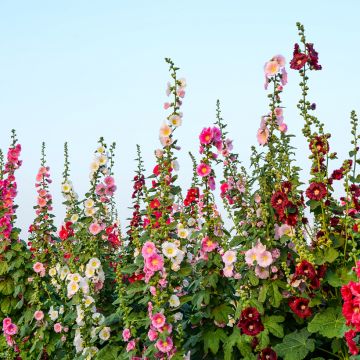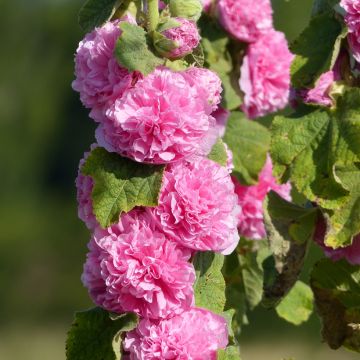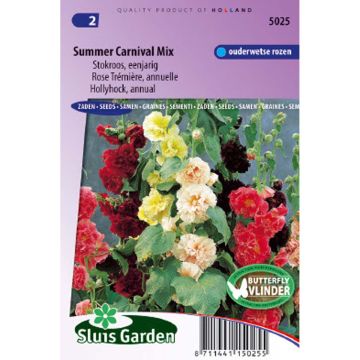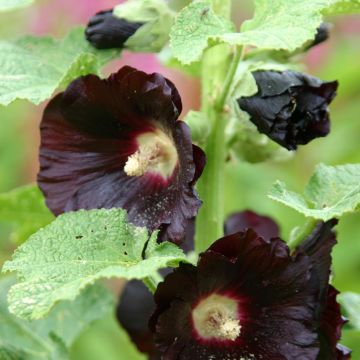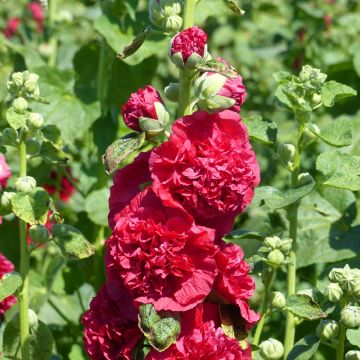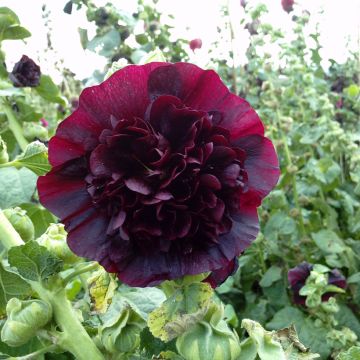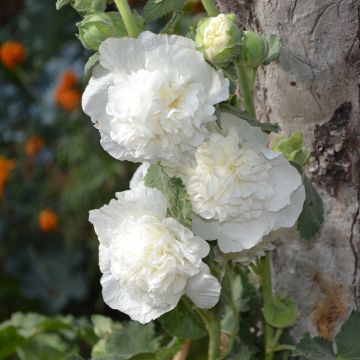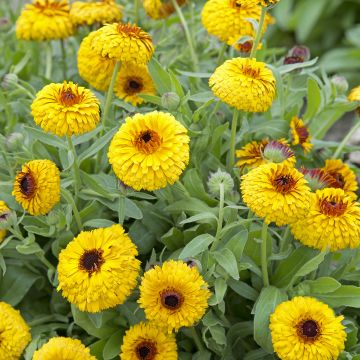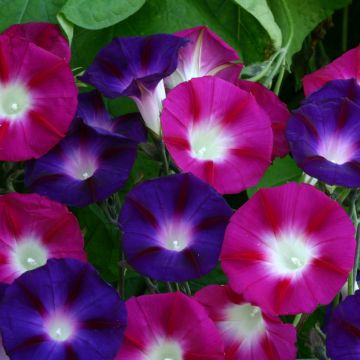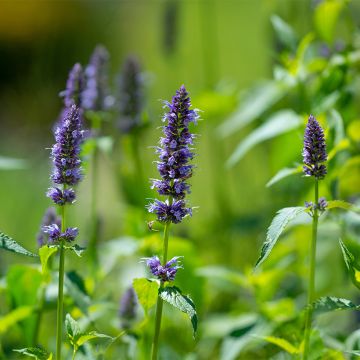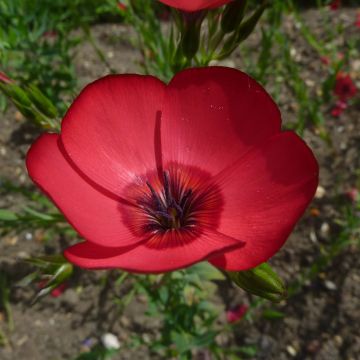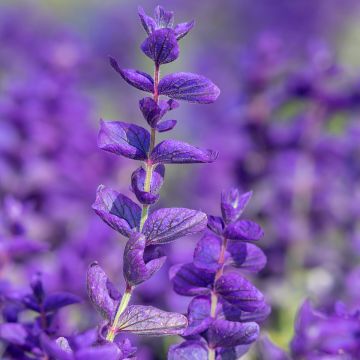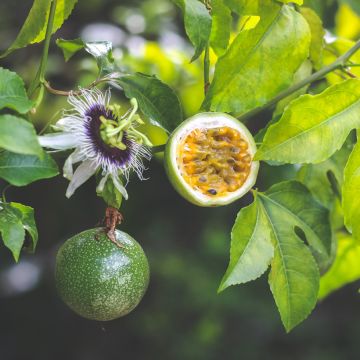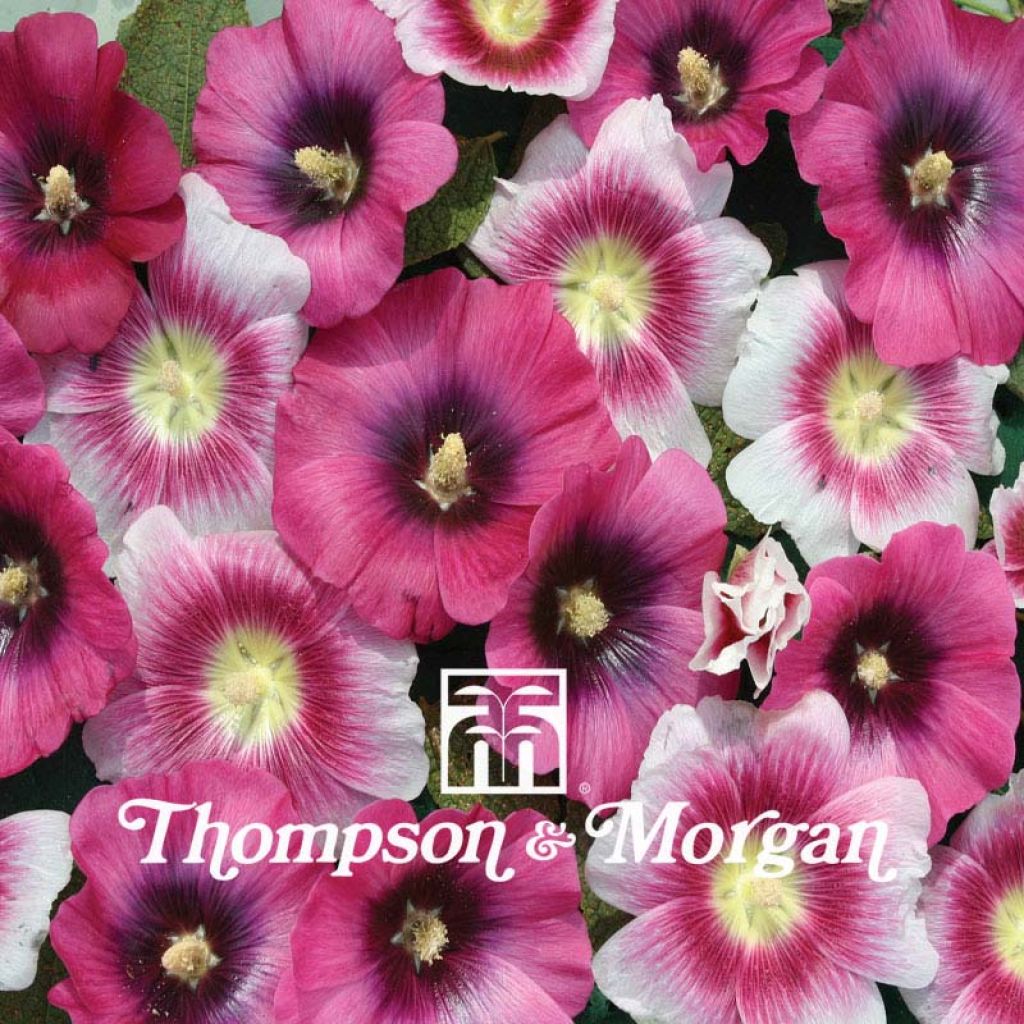

Graines de rose trémière Halo Perfect Pink - Alcea rosea
Alcea rosea Halo Perfect Pink - Hollyhock
Alcea rosea Halo Perfect Pink
Hollyhock
Why not try an alternative variety in stock?
View all →This plant carries a 6 months recovery warranty
More information
We guarantee the quality of our plants for a full growing cycle, and will replace at our expense any plant that fails to recover under normal climatic and planting conditions.
Seed-only orders are dispatched by sealed envelope. The delivery charge for seed-only orders is €3.90.
Does this plant fit my garden?
Set up your Plantfit profile →
Description
Alcea 'Halo Perfect Pink', a newcomer in the series of hollyhocks in the Halo series, brings together varieties in different shades of pink, but always bicoloured. Each produces 5 to 10 tall stems loaded with large single flowers ranging from pale-pink to almost red-purple, adorned with a halo and/or a darker heart. It is more perennial than usual varieties, and its foliage resists rust better. This plant is irreplaceable in country gardens or gardens without a gardener. It can do without watering once established and often self-seeds in unexpected places.
Alcea rosea belongs to the Malvaceae family. It is native to Asia Minor and is often naturalised in wild gardens, fallow lands, and on mounds of earth. The result of several years of selection, 'Halo Perfect Pink' is part of a series of hybrids selected by the famous seed supplier Thompson & Morgan for their large single and bicoloured flowers, bushy habit, their ability to produce several flower stems on the same plant, and their rust resistance.
It is an upright plant, usually unbranched, that can reach 1.5 to 2m (5 to 7ft) in height. It forms a branched rosette of rounded and puckered leaves from which several robust flower stems emerge. It has a very rapid growth rate. The spike-like inflorescences are covered with numerous large buds that open in a staggered pattern from June to August. They bloom from the bottom to the top, into large single flowers with a diameter of 10cm (4in). Their satin texture creates beautiful plays of light. Throughout this period, they will attract bees and butterflies to your garden. The flowering gives way to numerous fruits filled with seeds that self-seed spontaneously in unexpected places: at the base of walls, in poor and rocky soils, and cracks in walls.
Very common in abandoned gardens or fallow land in our countryside, hollyhocks are often grown at the back of borders or against a wall that protects it from strong winds. This lovely selection 'Halo Perfect Pink' will create stunning combinations with purple, mauve, or white forms, both single and double. Plant or sow it with annuals such as nigella, bidens, centaurea, cosmos, poppies, and Delphinium consolida. Gaura, with their light flowering like a flight of butterflies, will also form a beautiful contrast with their stems loaded with large flowers. Hollyhock is an edible plant; the floral buds can be consumed raw in salads and the young leaves raw or cooked.
It is both ornamental and medicinal. Oil with drying properties is obtained from its seeds. Rich in mucilage, it has soothing, emollient, expectorant, laxative, and appetising properties, albeit attenuated compared to those of its cousin, Althea officinalis.
Report an error about the product description
Flowering
Foliage
Plant habit
Botanical data
Alcea
rosea
Halo Perfect Pink
Malvaceae
Hollyhock
Cultivar or hybrid
Other Hollyhock seeds
Planting and care
Sow the seeds from May to July. It takes about 15 to 20 days for the young shoots to appear. Transplant the young plants when they reach a height of 7cm (3in). Plant at a distance of 20cm (8in) from each other. In the following spring, place them in your flower beds at a distance of 40 to 50cm (16 to 20in). Consider staking them if the location is not sheltered from the wind. Avoid planting hollyhocks in the same spot for several years in a row to prevent the appearance of rust (a parasitic fungus visible as orange powder) on the foliage. Hybrid hollyhocks tolerate summer drought and poor soils, but look much better in fertile soil that retains some moisture in summer. They tolerate limestone very well. In heavy and wet winter soil, these plants will be more biennial than truly perennial. Under optimal growing conditions, they can live for 4 or 5 years.
Sowing period
Intended location
This item has not been reviewed yet - be the first to leave a review about it.
Flower seeds
Haven't found what you were looking for?
Hardiness is the lowest winter temperature a plant can endure without suffering serious damage or even dying. However, hardiness is affected by location (a sheltered area, such as a patio), protection (winter cover) and soil type (hardiness is improved by well-drained soil).

Photo Sharing Terms & Conditions
In order to encourage gardeners to interact and share their experiences, Promesse de fleurs offers various media enabling content to be uploaded onto its Site - in particular via the ‘Photo sharing’ module.
The User agrees to refrain from:
- Posting any content that is illegal, prejudicial, insulting, racist, inciteful to hatred, revisionist, contrary to public decency, that infringes on privacy or on the privacy rights of third parties, in particular the publicity rights of persons and goods, intellectual property rights, or the right to privacy.
- Submitting content on behalf of a third party;
- Impersonate the identity of a third party and/or publish any personal information about a third party;
In general, the User undertakes to refrain from any unethical behaviour.
All Content (in particular text, comments, files, images, photos, videos, creative works, etc.), which may be subject to property or intellectual property rights, image or other private rights, shall remain the property of the User, subject to the limited rights granted by the terms of the licence granted by Promesse de fleurs as stated below. Users are at liberty to publish or not to publish such Content on the Site, notably via the ‘Photo Sharing’ facility, and accept that this Content shall be made public and freely accessible, notably on the Internet.
Users further acknowledge, undertake to have ,and guarantee that they hold all necessary rights and permissions to publish such material on the Site, in particular with regard to the legislation in force pertaining to any privacy, property, intellectual property, image, or contractual rights, or rights of any other nature. By publishing such Content on the Site, Users acknowledge accepting full liability as publishers of the Content within the meaning of the law, and grant Promesse de fleurs, free of charge, an inclusive, worldwide licence for the said Content for the entire duration of its publication, including all reproduction, representation, up/downloading, displaying, performing, transmission, and storage rights.
Users also grant permission for their name to be linked to the Content and accept that this link may not always be made available.
By engaging in posting material, Users consent to their Content becoming automatically accessible on the Internet, in particular on other sites and/or blogs and/or web pages of the Promesse de fleurs site, including in particular social pages and the Promesse de fleurs catalogue.
Users may secure the removal of entrusted content free of charge by issuing a simple request via our contact form.
The flowering period indicated on our website applies to countries and regions located in USDA zone 8 (France, the United Kingdom, Ireland, the Netherlands, etc.)
It will vary according to where you live:
- In zones 9 to 10 (Italy, Spain, Greece, etc.), flowering will occur about 2 to 4 weeks earlier.
- In zones 6 to 7 (Germany, Poland, Slovenia, and lower mountainous regions), flowering will be delayed by 2 to 3 weeks.
- In zone 5 (Central Europe, Scandinavia), blooming will be delayed by 3 to 5 weeks.
In temperate climates, pruning of spring-flowering shrubs (forsythia, spireas, etc.) should be done just after flowering.
Pruning of summer-flowering shrubs (Indian Lilac, Perovskia, etc.) can be done in winter or spring.
In cold regions as well as with frost-sensitive plants, avoid pruning too early when severe frosts may still occur.
The planting period indicated on our website applies to countries and regions located in USDA zone 8 (France, United Kingdom, Ireland, Netherlands).
It will vary according to where you live:
- In Mediterranean zones (Marseille, Madrid, Milan, etc.), autumn and winter are the best planting periods.
- In continental zones (Strasbourg, Munich, Vienna, etc.), delay planting by 2 to 3 weeks in spring and bring it forward by 2 to 4 weeks in autumn.
- In mountainous regions (the Alps, Pyrenees, Carpathians, etc.), it is best to plant in late spring (May-June) or late summer (August-September).
The harvesting period indicated on our website applies to countries and regions in USDA zone 8 (France, England, Ireland, the Netherlands).
In colder areas (Scandinavia, Poland, Austria...) fruit and vegetable harvests are likely to be delayed by 3-4 weeks.
In warmer areas (Italy, Spain, Greece, etc.), harvesting will probably take place earlier, depending on weather conditions.
The sowing periods indicated on our website apply to countries and regions within USDA Zone 8 (France, UK, Ireland, Netherlands).
In colder areas (Scandinavia, Poland, Austria...), delay any outdoor sowing by 3-4 weeks, or sow under glass.
In warmer climes (Italy, Spain, Greece, etc.), bring outdoor sowing forward by a few weeks.

































